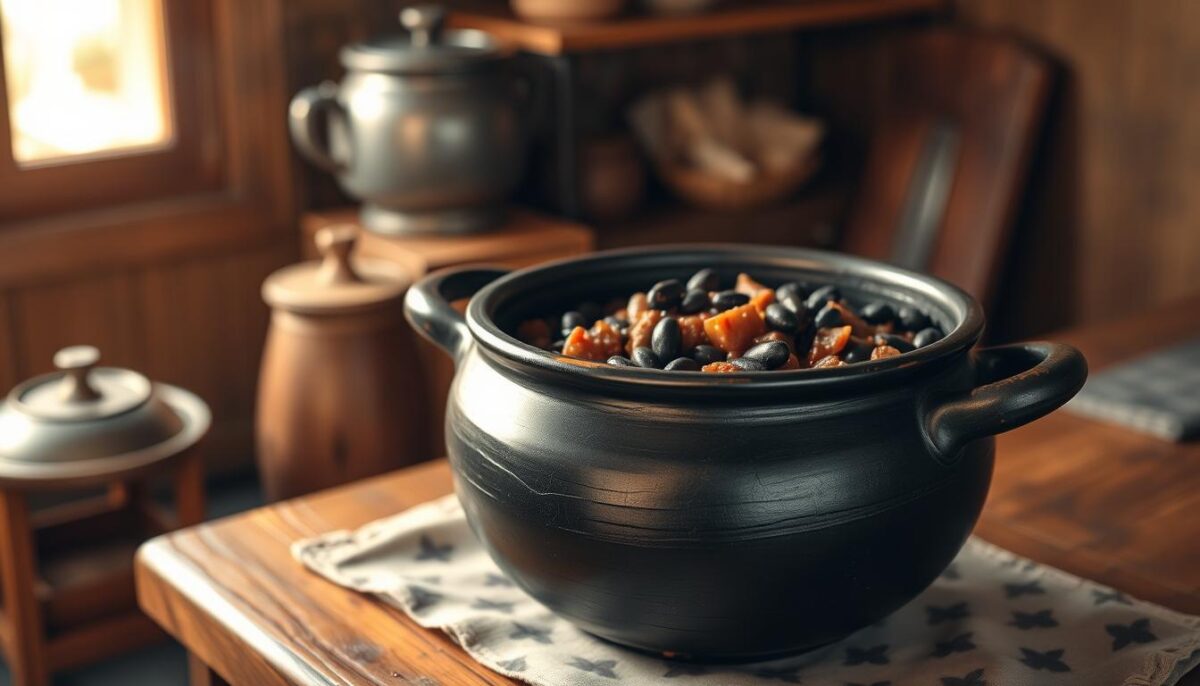
A Step-by-Step Guide to Making Greek Moussaka at Home
May 7, 2025
Mastering Moroccan Tagine with Aromatic North African Spices
May 7, 2025Did you know that over 70% of Brazilian households serve this iconic dish at least once a week? That’s how deeply rooted it is in the country’s culture. When I first tasted it at a friend’s family gathering, I understood why it’s more than just food—it’s a celebration of tradition and togetherness.
Growing up, Sundays meant simmering pots filling the kitchen with smoky, savory aromas. My version of this beloved meal combines time-honored techniques with practical shortcuts, perfect for busy home cooks. What makes it unforgettable? The harmony of tender black beans and slow-cooked meats creates layers of flavor you’ll crave for days.
This dish isn’t just about ingredients—it’s about connection. Every bite tells stories of family recipes passed through generations. Today, I’ll guide you through crafting this comfort food classic, from sourcing authentic components to mastering the simmer that transforms simple elements into something extraordinary.
Key Takeaways
- Discover the cultural significance of Brazil’s most cherished comfort food
- Learn why black beans and mixed meats create unmatched depth of flavor
- Get time-saving tips without sacrificing authentic taste
- Understand the dish’s role in family gatherings and celebrations
- Prepare to layer flavors using traditional slow-cooking methods
Introduction: Discovering the Feijoada Tradition
What if I told you that a simple pot of beans could unite a nation? This hearty creation began as peasant food but now graces tables during festivals and family gatherings. Its magic lies in transforming affordable cuts into something extraordinary—a testament to culinary ingenuity.
What Is This Iconic Dish?
At its core, it’s a harmony of black beans and slow-cooked meats. Think pork shoulder simmered until tender, paired with smoky dried cuts. My first encounter left me stunned—how could such humble ingredients create such depth? The answer lies in layering flavors over hours, letting each element meld perfectly.
Roots in Resourcefulness
Enslaved Africans and Portuguese colonizers shaped this dish’s story. Leftover pork parts—like ears and tails—were combined with beans, creating sustenance from scarcity. Over time, it evolved into a symbol of resilience. Today, variations might include beef or smoked sausage, but pork remains the star, connecting modern kitchens to centuries-old traditions.
Brazilian feijoada stew recipe: My Authentic Approach
The first time I stirred a bubbling pot of this hearty dish, I knew I’d found something extraordinary. Its earthy aroma wrapped around me like a warm hug, promising comfort in every spoonful. That moment in 2013 sparked a culinary love affair that’s only deepened over hundreds of simmering batches.

Why This Dish Stole My Heart
What keeps me coming back? It’s the alchemy of simple elements. A heavy Dutch oven becomes my partner here—its thick walls locking in heat to transform tough cuts into melt-in-your-mouth treasures. I’ll never forget how garlic sizzling in oil with smoky bacon became my kitchen’s signature scent.
Here’s what makes my approach unique:
| Element | Traditional Use | My Twist |
|---|---|---|
| Meats | One pork variety | 3 smoked sausages + applewood bacon |
| Seasoning | Basic salt | Kosher salt + roasted garlic paste |
| Cooking Vessel | Standard pot | Enameled cast iron |
“The magic happens when patience meets quality ingredients,” as Kimberly Killebrew once shared. That philosophy guides every step. Whether it’s rendering bacon fat to start or layering smoked meats over hours, this dish rewards attention to detail.
Want to taste the difference? Try letting your pot rest overnight. Those flavors intensify beautifully, proving some things truly get better with time—just like my relationship with this soul-warming creation.
Essential Ingredients and Tools
Ever wonder what transforms ordinary beans into a legendary meal? It’s not magic—it’s about choosing components that sing together. Let’s break down what you’ll need to build layers of flavor worthy of family traditions.
Key Meats and Beans
Start with dried black beans—their creamy texture beats canned versions every time. For meats, think variety:
- Beef short ribs add richness
- Smoked ham hock brings depth
- Double-smoked ham delivers savory punches
Don’t skip bay leaves. These fragrant heroes infuse earthy notes that tie everything together. My trick? Use three fresh leaves, rubbing them between your palms to release oils before adding to the pot.
Must-Have Kitchen Essentials
A heavy dutch oven is non-negotiable. Its even heat distribution prevents scorching during long simmers. Pair it with:
- Wooden spoon for gentle stirring
- Fine-mesh skimmer to remove excess fat
- Sharp knife for trimming meats
When selecting beef, look for marbled cuts that melt into the broth. For smoked ham, seek out artisanal brands—their balanced saltiness elevates the entire dish. Remember, great tools respect the labor of love behind every simmering pot.
Step-by-Step Cooking Process
Ever caught yourself daydreaming about a meal that builds flavor with every stir? This journey begins with dried beans and ends with a pot so fragrant, your kitchen becomes a time machine. Let’s walk through each phase carefully—patience here rewards you tenfold.

Prepping and Soaking the Beans
Rinse 2 cups of dried black beans thoroughly. Soak them overnight in cold water—enough to cover by three fingers. This plumps them up for creamy texture later. Drain completely before cooking.
Browning Meats and Sautéing Aromatics
Heat your Dutch oven over medium-high heat. Sear 1 lb beef short ribs until golden—about 4 minutes per side. Remove, then cook ½ lb smoked sausage slices until crispy edges form. Add diced onions and minced garlic, stirring until translucent.
Simmering to a Rich, Flavorful Stew
Return meats to the pot with beans and 8 cups water. Bring to a boil, then reduce heat to low. Nestle in a smoked ham hock—its collagen will thicken the liquid beautifully. Cover and simmer 3 hours, stirring occasionally.
Spotting too much liquid? Remove the lid during the last 30 minutes. Too thick? Add ¼ cup warm water. The magic happens when beans soften into velvety pockets cradling tender meats. Skim excess fat with a spoon—your future self will thank you.
Flavor Enhancements, Variations, and Serving Suggestions
What truly makes this dish shine? The freedom to make it your own while honoring its roots. Through years of experimenting, I’ve discovered simple tweaks that elevate flavors without losing tradition’s essence.

Personal Touches and Recipe Variations
For a smoky kick, I add a teaspoon of chipotle pepper to the simmering pot. Swap diced pancetta for bacon if you prefer richer notes. Vegetarian friends love my meat-free version with roasted mushrooms and smoked paprika—it still delivers that deep, earthy character.
Don’t shy away from extra onion! Caramelizing an extra half cup creates sweetness that balances salty meats. My secret weapon? A splash of apple cider vinegar stirred in during the last 30 minutes—it brightens every bite.
Traditional Sides and Accompaniments
Fluffy white rice is non-negotiable—it soaks up the rich broth beautifully. Pair it with garlicky collard greens sautéed in olive oil. The crisp texture cuts through the dish’s richness like a fresh breeze.
Always serve with orange slices. Their citrus zing resets your palate between hearty spoonfuls. For heat lovers, offer a fiery chili sauce on the side. I sometimes garnish with extra orange slices and chopped parsley—it adds vibrant color and freshness.
Remember: Great meals are about balance. A cold beer or caipirinha cocktail completes the experience, turning dinner into a festive gathering. Your table, your rules—make it memorable!
Conclusion
There’s something magical about a dish that carries centuries of stories in every bite. Through this journey, we’ve explored how simple elements like beans, fragrant bay leaves, and time-honored techniques create comfort that transcends borders. Each simmering pot connects us to resourceful cooks who turned humble ingredients into lasting legacies.
Success lies in the details. Choosing quality beans, layering meats like ham hock, and maintaining enough water during cooking ensures that velvety texture we all crave. Your oven becomes a storyteller here—transforming patience into rich, soul-warming results.
Now it’s your turn. Adjust spice levels, swap greens, or add a splash of citrus. What matters is making it yours while honoring its roots. Thank you for letting me share this piece of culinary heritage—may your kitchen echo with laughter and clinking spoons.
Final tip? Let tradition guide you, but don’t fear innovation. After all, the best meals blend history with heart.
FAQ
Can I use canned beans instead of dried ones?
I prefer dried black beans for their texture and depth, but canned beans work in a pinch. Just reduce the simmering time and adjust the salt since canned beans are pre-cooked.
What if I can’t find smoked ham hock or linguiça sausage?
No worries! Smoked bacon or turkey legs can replace ham hock, and chorizo or kielbasa add a similar richness if linguiça isn’t available. Adapt based on what’s local to you.
How long does it take to cook the meats until tender?
Low-and-slow is key. Pork shoulder and beef usually need 2–3 hours, but check with a fork. If it shreds easily, you’re golden. Don’t rush this step—it builds flavor!
Can I skip soaking the beans overnight?
Soaking cuts cooking time and helps beans cook evenly, but a quick-soak method works too. Boil them for 5 minutes, then let sit for an hour off the heat before draining.
What sides pair best with this dish?
I serve mine with fluffy white rice, collard greens sautéed with garlic, and orange slices for brightness. Farofa (toasted cassava flour) adds a crunchy texture too!
Is there a way to make this stew less heavy?
Absolutely! Swap pork shoulder for leaner cuts like turkey or chicken, and add extra veggies like carrots or squash. It’ll still taste hearty without weighing you down.



